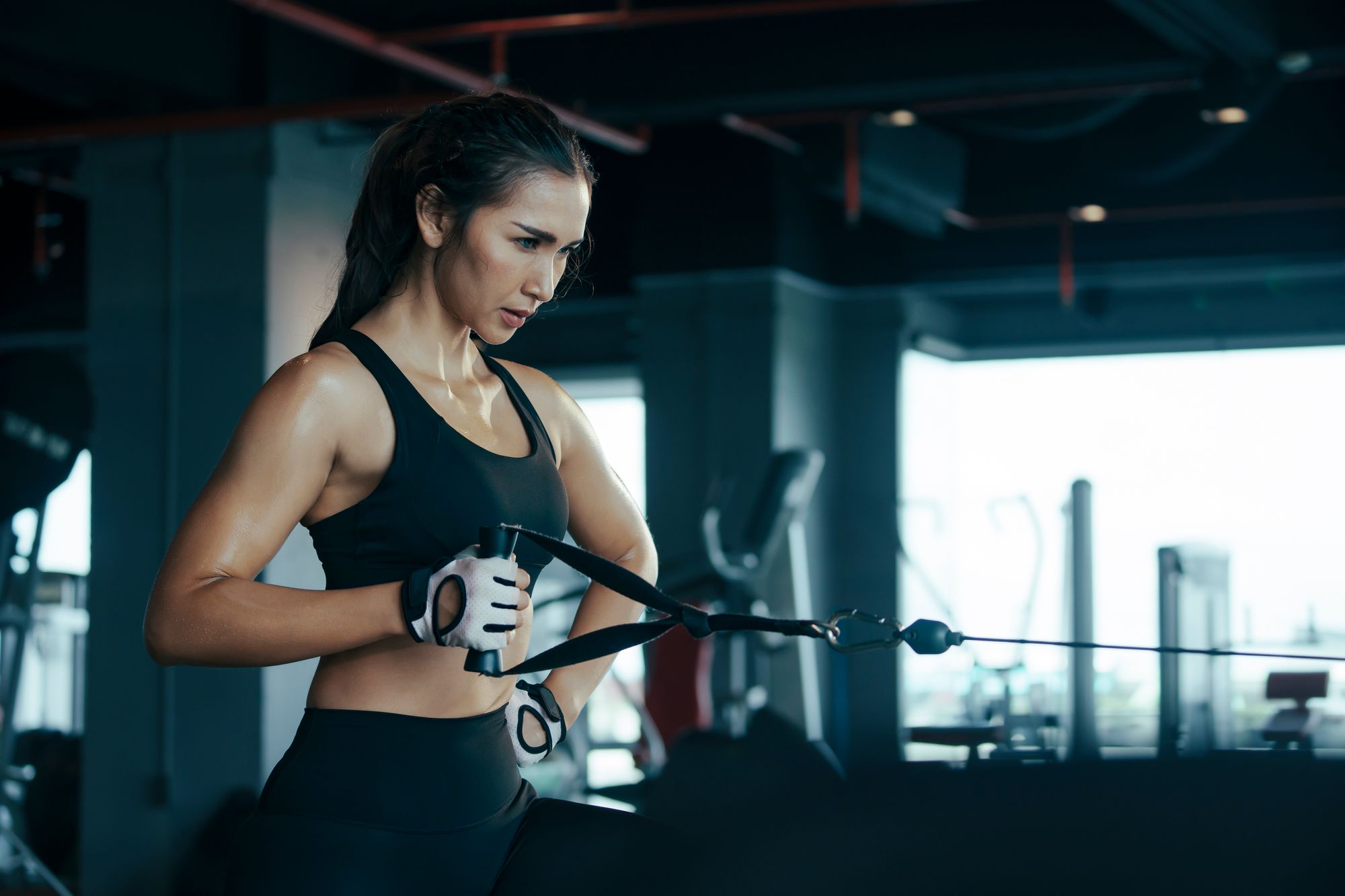9 Best Shoulder Exercises for Injury-Proof Boulder Shoulders
You know what you want your shoulders to look like. But the shoulder exercises that'll get you there? No (or little) clue. Let's change that now.

You know what you want your shoulders to look like.
*Cue lust-worthy images of Chris Hemsworth as Thor — in Thor: Love and Thunder, not Avengers: Endgame — and Alicia Vikander in Tomb Raider* 🤤
Getting there, though (i.e., knowing how to grow your shoulders)? No idea. Well, OK, maybe you have just the tiniest inkling of the type of shoulder exercises you need to do:
- Overhead presses
- Side raises
- Face pulls???
… but despite haphazardly doing them in your workout routine, you haven’t actually seen them do anything for your shoulders.
Enough is enough. It's time to end your confusion, overwhelm, and frustration.
Below, you’ll find the exact best shoulder exercises (9 of them, to be specific) for boulder shoulders.
Better still, they’ll also help you ward off nasty shoulder injuries, like shoulder impingement, so you enjoy years of unimpeded muscle-building life.
Shoulder muscles anatomy
Before diving into the best shoulder exercises, it's crucial that you first understand this: your shoulders aren't just one muscle group.
Instead, each shoulder is made up of three distinct muscle groups responsible for different functions:
Lateral deltoids (“Side delts”): These help move your arm out to the side. Imagine walking shoulder-to-shoulder with a friend, and you give them a friendly backhand slap on the chest — you’re activating your side delts.
Posterior deltoids (“Rear delts”): Like your rotator cuffs, these help stabilize your shoulders (i.e., they’re suuuuper important in preventing shoulder injuries). Imagine pulling back your shoulders when you notice you're hunched over the keyword — you're activating your rear delts.
What are the best shoulder exercises you need to care about?
Since every shoulder “region” performs a different function, it’ll only make sense that you’d have to pick different shoulder exercises to target and optimally grow each.
Front delts
Now, let’s talk about the front delts first.
Because they’re responsible for raising the arms forward, any form of front raises (e.g., dumbbell or cable front raises) must be the best at growing the front delts … right?
Here’s shocking news: no.
According to a 2000 study, the standing overhead barbell press resulted in a 40% increase in front delts activation compared to front raises.
Um, but that doesn’t make any sense? We’re no psychics, but that’s probably what you were wondering, so let’s dive into the 2 reasons standing overhead press outperformed the front raises:
2️⃣ Load: Muscle growth positively correlates with training volume (up to a certain point). Due to their nature, front raises limit the weight you can use — imagine trying to do your front raises with 35 kg dumbbells! You wouldn't see this "loading issue" with the overhead barbell press.
OK, so that’s one shoulder exercise down for the front delts ✔️ What other shoulder exercises are there? Here are 2 more to add to your repertoire:
- Seated dumbbell shoulder press: This increases stability, which means you can push heavier weights. And will that give you better growth? Most likely. Better still, this exercise will also help you identify and work on any muscle imbalances.
- Kneeling landmine press: Targets your front delts + builds your scapular stability + activates your core. What else could you want from this front delts exercise?
TL; DR: Best shoulder exercises for the front delts (You’re welcome.)
- Standing overhead barbell press
- Seated dumbbell press
- Kneeling landmine press
Side delts
Side delts = responsible for raising your arms to the side of your body. So, the best shoulder exercises for them will be lateral raises, right?
Yes, you’re right!
And so because of that, this section will be a lot more straightforward. Here are the 3 lateral raises worthy of your attention:
- Dumbbell lateral raise: The most important rule to remember is to lift in the scapular plane (i.e., 45 degrees relative to your torso) instead of straight out to your sides. This puts your shoulders in a much kinder position — and lowers your risk of shoulder injuries. Read this article for more form tips.
- Lean-away cable lateral raise: With the dumbbell lateral raise, the highest tension point is near the bottom. But, as we all know now, muscles grow best when subjected to a variety of tension. Cables provide exactly that by shifting the highest tension point to the exercise's top position.
- Standing cable Y-raise: For the health of your shoulder joints, raising your arms above shoulder height on the dumbbell lateral raises and lean-away cable lateral raises isn’t encouraged. This means your side delts cannot achieve a full contraction. The standing cable Y-raise changes that while maintaining your shoulders in a safe position.
Rear delts
Time for rear delts. What are the best shoulder exercises for this region?
If your answer includes face pulls, we're sorry to say you're wrong. That's because research shows your rear delts are best activated when:
- The exercise’s tension aligns with how its muscle fibers run — which is actually at a 45-degree angle downward, away from your body (much like your front delts, but flipped)
- You’re able to pull your elbows back beyond your torso; this allows for full contraction of the rear delts
Face pulls achieve neither.
But this begs an important question: which exercises do, then? Well, here are 3 known to blow up your rear delts (make sure to pull with your elbows at a 45-degree angle away from your torso — and think about pulling them as far “back” as possible):
- Chest-supported rear delts dumbbell row: Get your bench set at a ~30 degrees incline.
- Rear delt cable row: This is pretty much the same as your chest-supported rear delts dumbbell row, only you're using the cable machine now. If you find hitting a 45-degree angle challenging on this exercise, switching to a wider attachment may help.
- Rear delt cable pull: Credit for this exercise goes to Coach Paul Carter. See how it's performed here. What makes this exercise different from the previous 2 is that this shifts the point of highest tension to the "top position" of the movement. And as mentioned earlier, this is highly beneficial to muscle growth.
Go beyond simply knowing the best shoulder exercises
Congratulations!
You now know the 9 best shoulder exercises to include in your workout routine for injury-proof boulder shoulders. But there's just one problem … knowing is one thing while implementing it is another.
Questions you may be struggling with right now may include:
🤔 Do I fit all these into a single workout session?
- If no: which should I prioritize, and which should I eliminate?
- If yes: how does it work? Wouldn’t I need to spend hours in the gym?
🤔 How many times a week should I train my shoulders?
🤔 What should I train my shoulders with/before/after for optimal muscle growth?
If these questions are the exact ones circling your mind like vultures around a close-to-death animal (or, at the very least, close to them), you'd appreciate GymStreak.
This smart, AI-powered personal trainer app takes care of all your workout programming needs (not just for your shoulders! It’s a whole body kinda thing!) It’ll tailor your training plan to your unique:
- Lifting experience
- Fitness goals
- Ideal training frequency
… all so you don't have to. All you have to do? Show up and give your best; it'll take care of the rest.
Here’s a sneak peek of it in action:
This Way To Tailored, Done-For-You Workout Plans
We'll guide you through it all — step-by-step. Just download the app, and you'll achieve your dream shoulders (and body) in no time.
References
Ehlers Botton, C. (2013). Electromyographical analysis of the deltoid between different strength training exercises. Medicina Sportiva / English Edition, 17(2), S. 67-71.
Kolber, M. J., Cheatham, S. W., Salamh, P. A., & Hanney, W. J. (2014). Characteristics of shoulder impingement in the recreational weight-training population. Journal of Strength and Conditioning Research, 28(4), 1081–1089. https://doi.org/10.1519/JSC.0000000000000250
Sato, S., Yoshida, R., Kiyono, R., Yahata, K., Yasaka, K., Nunes, J. P., Nosaka, K., & Nakamura, M. (2021). Elbow Joint Angles in Elbow Flexor Unilateral Resistance Exercise Training Determine Its Effects on Muscle Strength and Thickness of Trained and Non-trained Arms. Frontiers in Physiology, 12, 734509. https://doi.org/10.3389/fphys.2021.734509
SuppVersity EMG Series - M. Deltoideus, M. Infraspinatus, Supraspinatus and Teres Minor: The Very Best Exercises for Broad Shoulders and Capped Delts. (n.d.). SuppVersity EMG Series - M. Deltoideus, M. Infraspinatus, Supraspinatus and Teres Minor. Retrieved January 18, 2023, from https://suppversity.blogspot.com/2011/08/suppversity-emg-series-m-deltoideus-m.html

